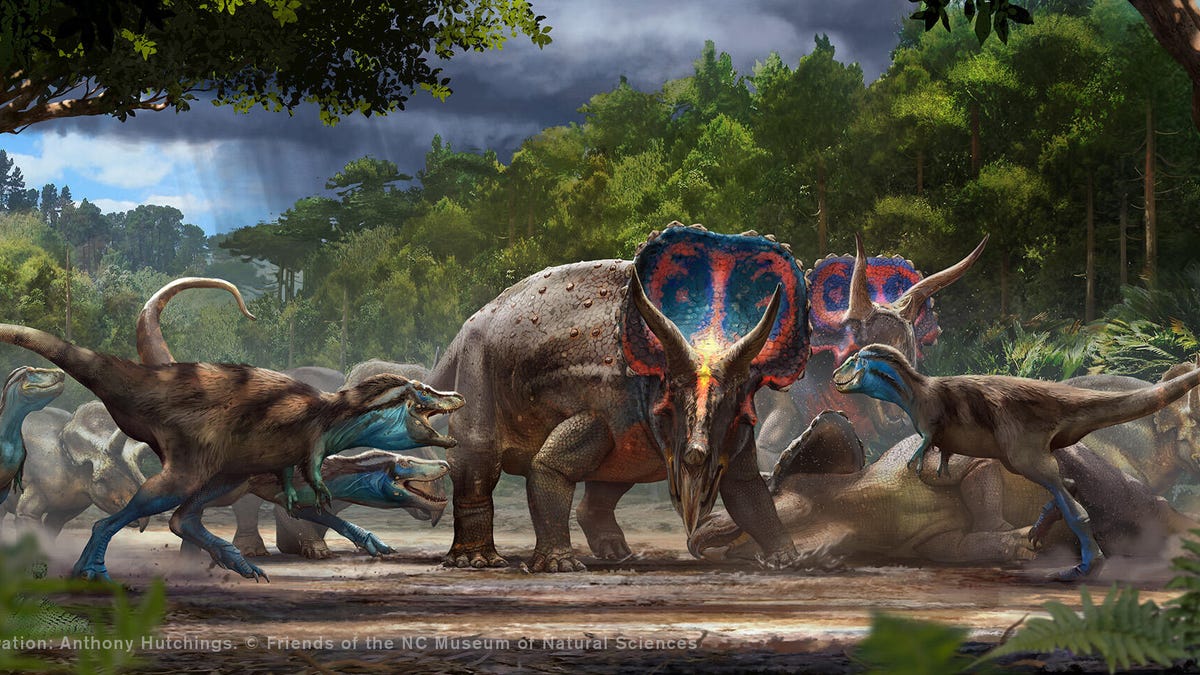One-of-a-kind fossil shows T. rex and Triceratops locked in battle to the death
The fossil, nicknamed "Dueling Dinosaurs," will be on public display for the first time.

Artist Anthony Hutchings' rendering of battling Tyrannosaurus rex and Triceratops horridus.
When you imagine dinosaurs battling it out, the first match-up that comes to mind is Triceratops vs. T. rex. In our collective imagination they are fighting eternally. It's the clash of the titans. But did these battles actually take place?
Yes. Yes they did. We have the fossil to prove it, and for the first time ever, the public will be able to take a look.
The fossil -- nicknamed "Dueling Dinosaurs" -- was initially discovered in 2006, but until now has only been seen by a select few. It shows a T. rex and a Triceratops in mid-battle, literally fighting to the death. The pair are preserved in a fossil going on display for the first time at the North Carolina Museum of Natural Sciences, The Charlotte Observer reported on Nov. 17.
The fossil shows the Triceratops and T. rex to date, preserved together in an unusual predator-prey encounter.
Unlike other museum displays where the dinosaur skeletons are preserved then assembled to stand proudly, the North Carolina Museum of Natural Sciences plans on displaying this fossil encased in sandstone, as staff paleontologists slowly take away the sediment that surrounds the bones.
Why's this important? The specimen includes the best-preserved skeletons of Triceratops and T. rex to date.
— NC Museum of Natural Sciences (@naturalsciences) November 17, 2020
We'll have the only 100% complete skeleton of T. rex ever found. Both dinosaurs were preserved together in a potential predator-prey encounter. pic.twitter.com/HbZmAngpWW
Museum visitors will also be able to ask the working paleontologists questions while they work on the exhibit.
"There's such a gold mine of scientific information to be discovered," Museum Director Eric Dorfman told The Charlotte Observer. "We already have a fantastic reputation for letting people see science unfold in real time. People can walk up and see researchers do the work they do. This fossil lets us take that idea with people engaging in science in real time to the next level."
Through this gift, our world-renowned researchers have access to rare biological data typically lost during preservation.
— NC Museum of Natural Sciences (@naturalsciences) November 17, 2020
The fossils show incredible features like body outlines, skin impressions, soft tissues, injuries and more, to ensure decades of research. pic.twitter.com/oNU8h7XRBp
The fossils were acquired for $6 million by the nonprofit organization Friends of the North Carolina Museum of Natural Sciences via private funds and will be gifted to the Museum's Vertebrate Paleontology Collection. The museum's construction on the SECU DinoLab begins in 2021.
"We have not yet studied this specimen; it is a scientific frontier. The preservation is phenomenal, and we plan to use every technological innovation available to reveal new information on the biology of T. rex and Triceratops. This fossil will forever change our view of the world's two favorite dinosaurs," said Dr. Lindsay Zanno, head of paleontology at the North Carolina Museum of Natural Sciences said in a statement.

